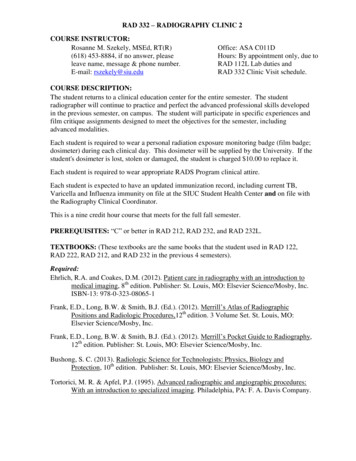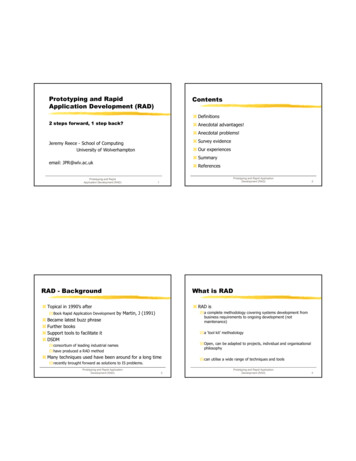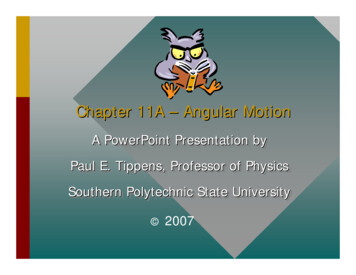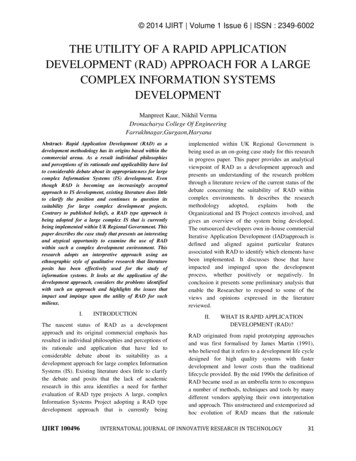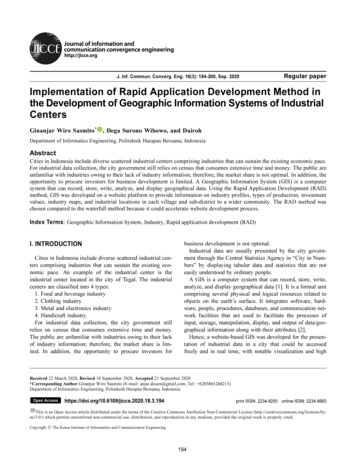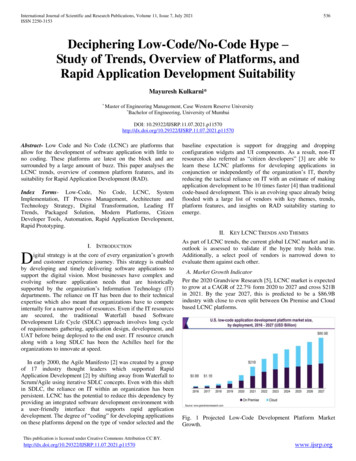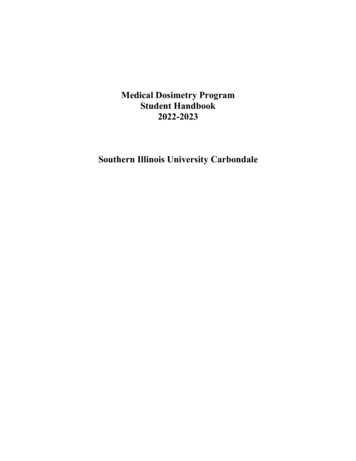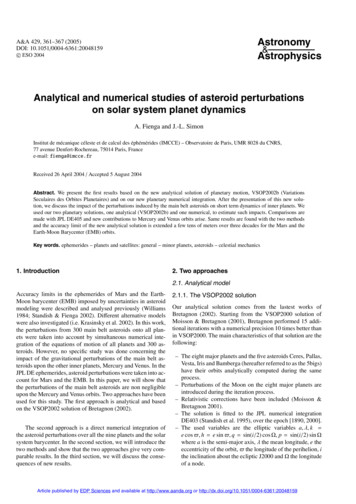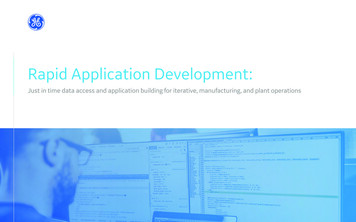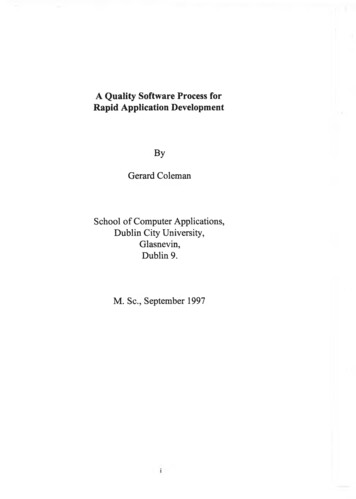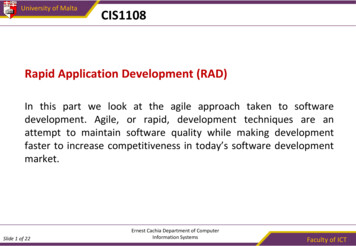
Transcription
University of MaltaCIS1108Rapid Application Development (RAD)In this part we look at the agile approach taken to softwaredevelopment. Agile, or rapid, development techniques are anattempt to maintain software quality while making developmentfaster to increase competitiveness in today’s software developmentmarket.Slide 1 of 22Ernest Cachia Department of ComputerInformation SystemsFaculty of ICT
University of MaltaAgile Development Principles1. Priority given to individuals and interaction, rather than toprocesses and tools (trust, personal communication, quality of work,responsibility, self-management at micro-level)2. Attention to working parts of solution, rather than tocomprehensive documentation (tangible results, client reassurance,evident solution parts)3. Importance to customer involvement, rather than contractualdetachment (stakeholder participation, transparency, collaboration, feedback,client acceptance)4. Reactive to change, rather than railed into a rigid plan (flexibility,relevance, result effectiveness, client satisfaction)General points only taken from www.agilealliance.orgSlide 2 of 22Ernest Cachia Department of ComputerInformation SystemsFaculty of ICT
University of Malta1.RAD PrinciplesAll stakeholders- must take active part in decision taking- can take binding decisions2.Deliverables- are frequent- must clearly map on to the business process- are bite-sized3.4.All development effort is reversibleRequirements are agreed upon at a high level- the method of their actual implementation is not that important5.6.Slide 3 of 22Testing permeates the SDLCCollaboration, not competition between stakeholders is ofessenceErnest Cachia Department of ComputerInformation SystemsFaculty of ICT
University of Malta Main RAD FeaturesUser involvementStrict (and usually fast) delivery timesPrototypingEffective use of modern development toolsReduction of the requirements capture and analysis effortIncremental developmentThe next slides will go through each featureSlide 4 of 22Ernest Cachia Department of ComputerInformation SystemsFaculty of ICT
University of Malta Slide 5 of 22User InvolvementJADDecision takingSign-offsPrototype demosBite size development focusProblem detection and correctionErnest Cachia Department of ComputerInformation SystemsFaculty of ICT
University of MaltaStrict Delivery Times Timebox approach 2 to 6 weeks Prioritisation (MoSCoW rules) Must, Should, Could, Want to have User agreement Power of decisionSlide 6 of 22Ernest Cachia Department of ComputerInformation SystemsFaculty of ICT
University of Malta Slide 7 of 22PrototypingThe main communication tool in RADRequires planningServe as milestonesShould be measureableCan take any form horizontal or verticalIs generally evolutionary in natureErnest Cachia Department of ComputerInformation SystemsFaculty of ICT
University of MaltaEffective use of Modern TechniquesThe “educated” use of: Slide 8 of rnest Cachia Department of ComputerInformation SystemsFaculty of ICT
University of MaltaReduction of Requirements Capture andAnalysis Effort Less time on getting every part right as early as possible atmodel level, producing a “ready” solution. More time on doing smaller bits, asking for feedback,combining the bits to “grow” the solution. Shift of some analysis effort from developer to user.Slide 9 of 22Ernest Cachia Department of ComputerInformation SystemsFaculty of ICT
University of Malta Slide 10 of 22Incremental DevelopmentThe current version of evolves from a simpler previous versionDevelopment can be subdivided into manageable partsRequires good configuration management to workSmall development chunks are a mustFrequent deliverables are a mustErnest Cachia Department of ComputerInformation SystemsFaculty of ICT
University of MaltaDSDM- An SDLC based on RAD Dynamic Systems Development Method (DSDM) Is a standard used throughout the UK and a number of othercountries. Yet others, use it sparingly Is an “open” method – i.e. non-commercialised Is supported by a consortium also called the “DSDMConsortium”see site: dsdm.org (registration might be required)Slide 11 of 22Ernest Cachia Department of ComputerInformation SystemsFaculty of ICT
University of MaltaThe DSDM FrameworkFrom http://dsdm.orgSlide 12 of 22Ernest Cachia Department of ComputerInformation SystemsFaculty of ICT
University of MaltaDSDM Does not specify a particular method of development to use inits phases Just offers a framework upon which development may proceedand at which points and what sort of milestone to produce Really only covers analysis, design and implementation phasesSlide 13 of 22Ernest Cachia Department of ComputerInformation SystemsFaculty of ICT
University of MaltaRAD Principles (9 in all) (1/2)1.Win-Win (my addition)2.All stakeholders must take active part3.All stakeholders can take binding decisions4.Deliverables are frequent5.Deliverables must clearly map on to the business process6.Deliverables are bite-sizedSlide 14 of 22Ernest Cachia Department of ComputerInformation SystemsFaculty of ICT
University of MaltaRAD Principles (9 in all) (2/2)7.All development effort is reversible8.Requirements are agreed upon at a high level – i.e. themethod of their actual implementation is not that important9.Testing permeates the SDLC10. Collaboration, not competition between stakeholders is ofessenceSlide 15 of 22Ernest Cachia Department of ComputerInformation SystemsFaculty of ICT
University of MaltaThe DSDM FilterWhen to use DSDM? Answer these Is the functionality visible through the UIs? Can all end user classes be identified? Is the system heavy on computation? Is the system “large” and can it be sensibly split up? How time-constrained is the project? Are requirements abstract enough and can they changewithin limits?Slide 16 of 22Ernest Cachia Department of ComputerInformation SystemsFaculty of ICT
University of Malta Slide 17 of 22Systems that can benefit from DSDMInteractiveBased on UIs (functionally)User groups are clearly definedNot too complexCan be incrementally developedTime-wise guaranteedRequirements can be prioritisedRequirements can undergo changesErnest Cachia Department of ComputerInformation SystemsFaculty of ICT
University of MaltaExamples of Agile Methodologies XP (Taken to be generically representative of all the “agile”methodologies)This method was outlined in the previous slides Scrum (first created in 1994, commercially used in 2002/3)This method is based on iterative (usually 30-day) segments called “sprints”.Autonomous teams work in parallel on pre-prioritised requirements andsynchronise through short daily meetings called “Scrums”. Crystal (2002)This method is developer-centric. It assumes that the main project quality driver isthe quality of people. Also relies on frequent communication and lessintermediate deliverables. Adaptive Software Development (2000)This is a feature-oriented method that is driven by the development of features asunderstood by the client. Change is expected and risk is tackled “head-on” bytackling the most complex issues first.Slide 18 of 22Ernest Cachia Department of ComputerInformation SystemsFaculty of ICT
University of MaltaSummary The concepts behind agile development methods Rapid Application Development (RAD) Examples of some agile methodologiesSlide 19 of 22Ernest Cachia Department of ComputerInformation SystemsFaculty of ICT
Rapid Application Development (RAD) In this part we look at the agile approach taken to software development. Agile, or rapid, development techniques are an attempt to maintain software quality while making development faster to increase competitiveness in today'ssoftware development market. Faculty of ICT Ernest Cachia Department of Computer
